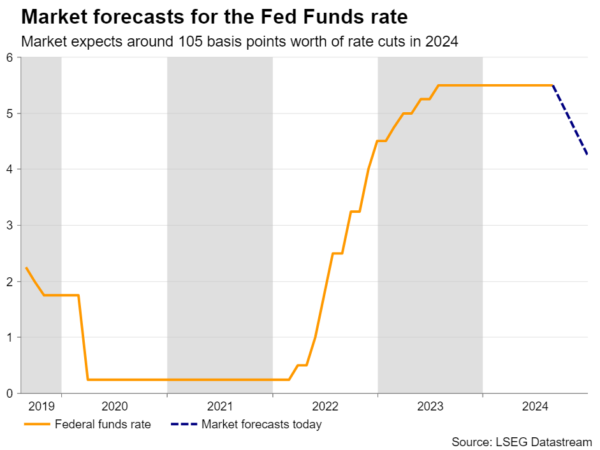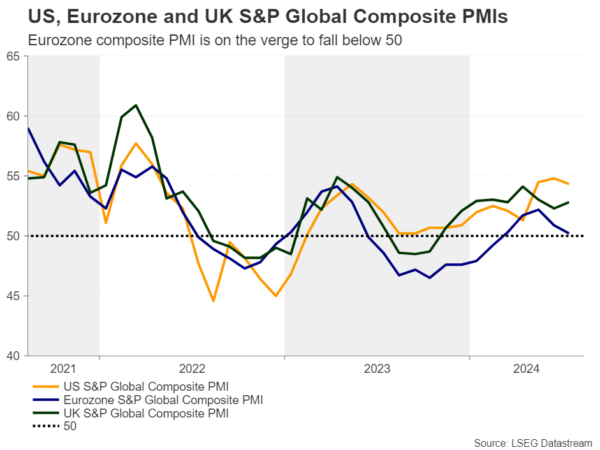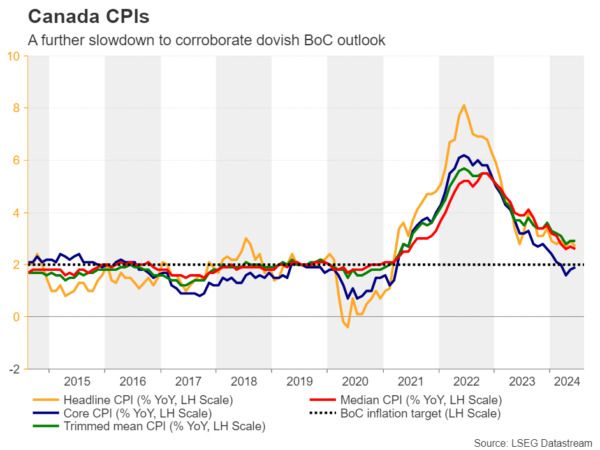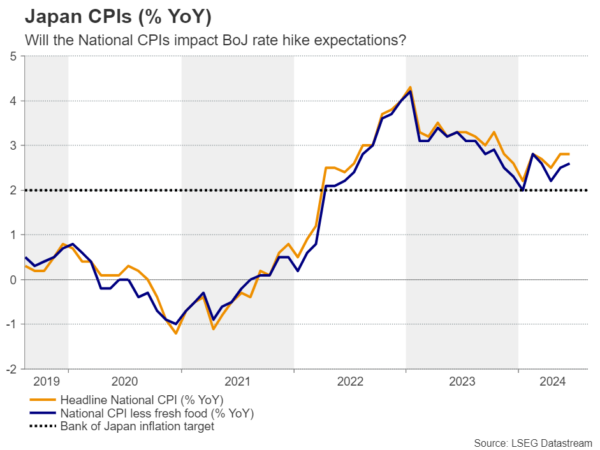- As recession fears ease, investors lock gaze on Jackson Hole
- Eurozone and UK PMIs to affect ECB and BoE expectations
- Canadian inflation could back third consecutive BoC cut
- Japan’s Nationwide CPI data also on the agenda
Jackson Hole to test overly dovish Fed cut bets
Following the unjustified panic triggered by the weaker-than-expected NFP report for July, investors have taken a calmer stance, thereafter, reevaluating their aggressive Fed rate cut bets as the incoming data suggested that the US economy is not faring as badly as initially feared.
That said, from penciling as many as 125bps worth of rate cuts by the end of the year at the start of last week, investors lifted their implied path only slightly. They are now expecting rates to be lowered by closer to 100bps, which remains an overly dovish bet as it means a reduction at each of the remaining decisions for 2024, including a 50bps cut.

The probability of a double cut at the upcoming meeting in September currently stands at about 25%, while such action is almost fully priced in for December. With that in mind, next week, investors will lock their gaze on the Fed’s Jackson Hole Economic Symposium, which will be held on August 22-24.
The theme will be “Reassessing the Effectiveness and Transmission of Monetary Policy”, suggesting that investors may have to digest a lot of commentary, not only from Fed Chair Powell and his colleagues, but from other major central bankers as well.
With inflation remaining close to 3%, it will be interesting to see whether Powell and other Fed members maintained their confidence about a downward trajectory in price pressures, and if so, how they are planning to move forward. Even if Powell repeats that the door to a September cut remains open, he is unlikely to satisfy those expecting hints about a double rate cut, which means that Treasury yields and the US dollar could still edge up.
Equity traders may be more eager to hear Powell’s take on the US economy, especially after the latest turmoil. Further reassurance that the risk of a recession is not elevated may allow Wall Street to march further north, even if expectations of very low borrowing costs are scaled back.
The minutes of the latest meeting are due to be released on Wednesday, but investors may prefer to pay more attention to the Jackson Hole symposium for more updated information and signals. The preliminary S&P Global PMIs for August on Thursday may also attract attention as investors remain eager to find out how the world’s largest economy is faring.
PMIs also on the front page of investors’ agenda
The preliminary S&P Global PMIs from the Eurozone and the UK are also due to be released that day.

Getting the ball rolling with the Eurozone, at its latest meeting, the ECB decided to keep interest rates unchanged, and although President Lagarde did not commit to a September cut, she sounded downbeat about the Eurozone’s growth outlook.
This allowed investors to nearly fully price in another 25bps reduction in September, and a set of downbeat PMIs may validate that view. That said, market participants may also dig into the minutes of the latest decision, due out the same day, for hints on how policymakers are planning to move forward.
In the UK, the Bank of England lowered interest rates on August 1 but signaled it will be ‘careful’ about cutting again. This week’s data revealed that the unemployment rate dropped to 4.2% from 4.4%, and that headline inflation rebounded somewhat to 2.2% y/y from 2.0%, even though the core rate slipped to 3.3% from 3.5%.
The data corroborated the BoE’s view, but still, there is around a 30% chance that policymakers will opt for a back-to-back reduction on September 19. For that probability to go higher, the PMIs may need to point to a significant deterioration in business activity.
Will CPI data halt the loonie’s recovery?
The Canadian CPI figures are scheduled to be released on Tuesday and the nation’s retail sales on Friday. The BoC cut interest rates by 25bps at each of the last two decisions, keeping the door open for more action down the line.
Investors are convinced that the Bank will continue cutting at each of the remaining decisions of the year and a further slowdown in inflation may add credence to that view, thereby weighing on the loonie at the time of the release.

However, currently, the oil-linked currency seems to be mainly driven by the rebound in oil prices, which is the result of supply concerns due to the increasing tensions in the Middle East, as well as easing demand worries as recession fears abate. Therefore, given that a dovish path is already priced in for the BoC, a further slowdown in inflation is unlikely to alter much the current outlook.
Japan’s CPI inflation also on tap
Finally, during the Asian session Friday, Japan releases its own Nationwide CPI numbers for July and according to the Tokyo prints for the month, headline inflation slowed but underlying prices continued to accelerate. If this is reflected on the national prints, then the probability for another BoJ hike by the end of the year may increase.

Nevertheless, even if this translates into a stronger yen, the latest relief in investors’ appetite is unlikely to allow the currency to stage a rally similar to that of the past few weeks. Interest rates in Japan remain very low compared to other major central banks, allowing some market participants to reuse the yen as a funding currency while increasing their risk exposures.









